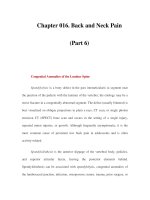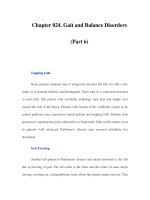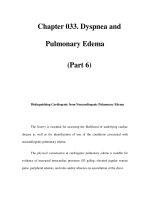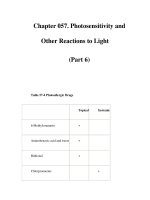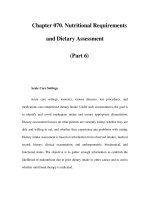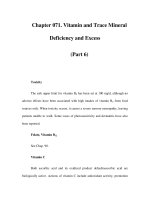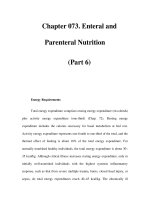Chapter 104. Acute and Chronic Myeloid Leukemia (Part 6) pps
Bạn đang xem bản rút gọn của tài liệu. Xem và tải ngay bản đầy đủ của tài liệu tại đây (34.48 KB, 5 trang )
Chapter 104. Acute and Chronic
Myeloid Leukemia
(Part 6)
Most patients are anemic and thrombocytopenic at presentation.
Replacement of the appropriate blood components, if necessary, should begin
promptly. Because qualitative platelet dysfunction or the presence of an infection
may increase the likelihood of bleeding, evidence of hemorrhage justifies the
immediate use of platelet transfusion, even if the platelet count is only moderately
decreased.
About 50% of patients have a mild to moderate elevation of serum uric acid
at presentation. Only 10% have marked elevations, but renal precipitation of uric
acid and the nephropathy that may result is a serious but uncommon complication.
The initiation of chemotherapy may aggravate hyperuricemia, and patients are
usually started immediately on allopurinol and hydration at diagnosis. Rasburicase
(recombinant uric oxidase) is also useful for treating uric acid nephropathy and
often can normalize the serum uric acid level within hours with a single dose of
treatment. The presence of high concentrations of lysozyme, a marker for
monocytic differentiation, may be etiologic in renal tubular dysfunction, which
could worsen other renal problems that arise during the initial phases of therapy.
Prognostic Factors
Many factors influence the likelihood of entering CR, the length of CR, and
the curability of AML. CR is defined after examination of both blood and bone
marrow. The blood neutrophil count must be ≥1000/µL and the platelet count
≥100,000/µL. Hemoglobin concentration is not considered in determining CR.
Circulating blasts should be absent. While rare blasts may be detected in the blood
during marrow regeneration, they should disappear on successive studies. Bone
marrow cellularity should be >20% with trilineage maturation. The bone marrow
should contain <5% blasts, and Auer rods should be absent. Extramedullary
leukemia should not be present. For patients in morphologic CR, reverse
transcriptase polymerase chain reaction (RT-PCR) to detect AML-associated
molecular abnormalities and either metaphase cytogenetics or interphase
cytogenetics by fluorescence in situ hybridization (FISH) to detect AML-
associated cytogenetic aberrations are currently used to detect residual disease.
Such detection of minimal residual disease may become a reliable discriminator
between patients in CR who do or do not require additional and/or alternative
therapies.
Age at diagnosis is among the most important risk factors. Advancing age
is associated with a poorer prognosis, in part because of its influence on the
patient's ability to survive induction therapy. Age also influences outcome because
AML in older patients differs biologically.
The leukemic cells in elderly patients more commonly express CD34 and
the multidrug resistance 1 (MDR1) efflux pump that conveys resistance to natural
product–derived agents such as the anthracyclines (see below).
With each successive decade of age, a greater proportion of patients have
more resistant disease. Chronic and intercurrent diseases impair tolerance to
rigorous therapy; acute medical problems at diagnosis reduce the likelihood of
survival. Performance status, independent of age, also influences ability to survive
induction therapy and thus respond to treatment.
Chromosome findings at diagnosis are important independent prognostic
factors. Patients with t(15;17) have a very good prognosis (approximately 85%
cured), and those with t(8;21) and inv(16) a good prognosis (approximately 50%
cured), while those with no cytogenetic abnormality have a moderately favorable
outcome (approximately 40% cured). Patients with a complex karyotype, t(6;9),
inv(3), or 7 have a very poor prognosis. This emphasizes the importance of
cytogenetic as well as the previously discussed molecular assessment of the
leukemia cells at diagnosis and relevance of storing samples for potential later use.
A prolonged symptomatic interval with cytopenias preceding diagnosis or a
history of an antecedent hematologic disorder is another pretreatment clinical
feature associated with a lower CR rate and shorter survival time. The CR rate is
lower in patients who have had anemia, leukopenia, and/or thrombocytopenia for
>3 months before the diagnosis of AML when compared to those without such a
history. Responsiveness to chemotherapy declines as the duration of the
antecedent disorder(s) increases. Secondary AML developing after treatment with
cytotoxic agents for other malignancies is usually difficult to treat successfully.
A high presenting leukocyte count is an independent prognostic factor for
attaining a CR. Among patients with hyperleukocytosis (>100,000/µL), early
central nervous system bleeding and pulmonary leukostasis contribute to poor
outcome with initial therapy.
In addition to pretreatment variables such as age, cytogenetics, and
leukocyte count, several treatment factors correlate with prognosis in AML,
including, most importantly, achievement of CR. In addition, patients who achieve
CR after one induction cycle have longer CR durations than those requiring
multiple cycles.
